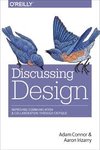
Saved by Daniel Wentsch
Discussing Design

Saved by Daniel Wentsch
Another common characteristic of bad critique is feedback that is justified by the giver from purely preferential thinking.
Examples of questions you might ask:Can you tell me more about what your objectives were for [specific aspect or element of the design]?What other options did you consider for [aspect/element]?Why did you choose this approach for [aspect/element]?Were there any influencers or constraints that affected your choices?
asking about design objectives
This is your chance to open up the dialogue. By asking questions you give yourself more information on which to base your analysis and give stronger, actionable feedback. If done in a noninterrogative way, it shows the designer that you’re genuinely interested in not only his work, but the thinking behind it, which can make discussing it and
... See moreAsk questions to give better feedback and show genuine interest
Good critique is comprised of three key elements:It identifies a specific aspect of the idea or a decision in the design being analyzed.It relates that aspect or decision to an objective or best practice.It describes how and why the aspect or decision work to support or not support the objective or best practice.
3️⃣ Key elements of good design critique
Central IdeaFeedback encompasses three forms: reaction, direction, and critique. Reaction and direction are limited in their ability to help us understand if the design choices we’ve made might work toward the product’s objectives. Critique, a form of analysis that uses critical thinking, is feedback that focuses on exactly that understanding.
Feedback consists of 3️⃣ parts: reaction, direction, and critique
Central IdeaGiving good critique is a skill that begins with the right intentions. Help the recipient understand how effective the design is by making sure that you’re avoiding selfish, untimely, incomplete, or preferential feedback and by following best practices.
setting the right intentions for critique
Critique isn’t about that instant reaction we might feel when seeing something, or about how we would change someone’s design to better solve an issue. Critique is a form of analysis that uses critical thinking to determine whether a design is expected to achieve its desired objectives (and adhere to any pertinent best practices or heuristics).
But, what about other aspects of the design? What about other questions that come up? For example:What new problems, complications, or successes might arise from the choices being proposed?What other objectives should the designer have been considering, but didn’t?Raising these kinds of questions can be important. Ignoring them might mean missing
... See moreadditional questions can be important but must be addressed with scope in mind
Don’t assumeFind out the thinking or constraints behind choices.“To assume makes an ass out of you and me.”